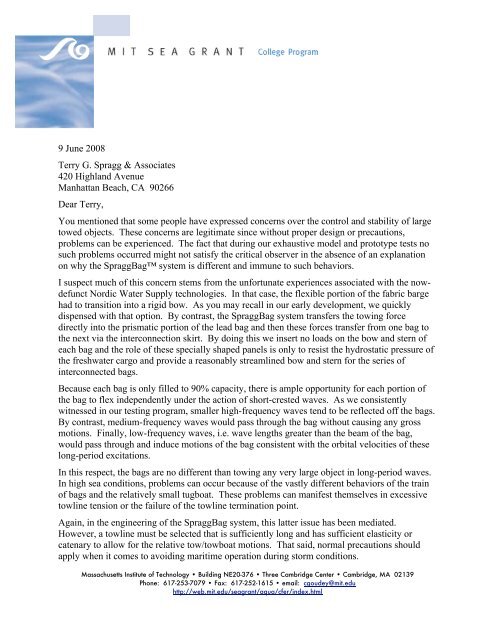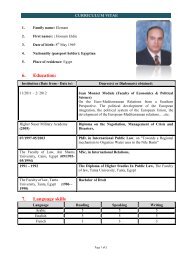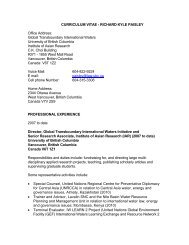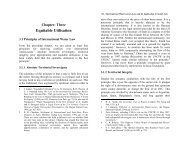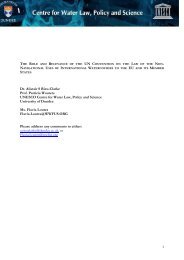a letter from research engineer, Cliff Goudey, of the MIT Sea Grant ...
a letter from research engineer, Cliff Goudey, of the MIT Sea Grant ...
a letter from research engineer, Cliff Goudey, of the MIT Sea Grant ...
Create successful ePaper yourself
Turn your PDF publications into a flip-book with our unique Google optimized e-Paper software.
9 June 2008<br />
Terry G. Spragg & Associates<br />
420 Highland Avenue<br />
Manhattan Beach, CA 90266<br />
Dear Terry,<br />
You mentioned that some people have expressed concerns over <strong>the</strong> control and stability <strong>of</strong> large<br />
towed objects. These concerns are legitimate since without proper design or precautions,<br />
problems can be experienced. The fact that during our exhaustive model and prototype tests no<br />
such problems occurred might not satisfy <strong>the</strong> critical observer in <strong>the</strong> absence <strong>of</strong> an explanation<br />
on why <strong>the</strong> SpraggBag system is different and immune to such behaviors.<br />
I suspect much <strong>of</strong> this concern stems <strong>from</strong> <strong>the</strong> unfortunate experiences associated with <strong>the</strong> nowdefunct<br />
Nordic Water Supply technologies. In that case, <strong>the</strong> flexible portion <strong>of</strong> <strong>the</strong> fabric barge<br />
had to transition into a rigid bow. As you may recall in our early development, we quickly<br />
dispensed with that option. By contrast, <strong>the</strong> SpraggBag system transfers <strong>the</strong> towing force<br />
directly into <strong>the</strong> prismatic portion <strong>of</strong> <strong>the</strong> lead bag and <strong>the</strong>n <strong>the</strong>se forces transfer <strong>from</strong> one bag to<br />
<strong>the</strong> next via <strong>the</strong> interconnection skirt. By doing this we insert no loads on <strong>the</strong> bow and stern <strong>of</strong><br />
each bag and <strong>the</strong> role <strong>of</strong> <strong>the</strong>se specially shaped panels is only to resist <strong>the</strong> hydrostatic pressure <strong>of</strong><br />
<strong>the</strong> freshwater cargo and provide a reasonably streamlined bow and stern for <strong>the</strong> series <strong>of</strong><br />
interconnected bags.<br />
Because each bag is only filled to 90% capacity, <strong>the</strong>re is ample opportunity for each portion <strong>of</strong><br />
<strong>the</strong> bag to flex independently under <strong>the</strong> action <strong>of</strong> short-crested waves. As we consistently<br />
witnessed in our testing program, smaller high-frequency waves tend to be reflected <strong>of</strong>f <strong>the</strong> bags.<br />
By contrast, medium-frequency waves would pass through <strong>the</strong> bag without causing any gross<br />
motions. Finally, low-frequency waves, i.e. wave lengths greater than <strong>the</strong> beam <strong>of</strong> <strong>the</strong> bag,<br />
would pass through and induce motions <strong>of</strong> <strong>the</strong> bag consistent with <strong>the</strong> orbital velocities <strong>of</strong> <strong>the</strong>se<br />
long-period excitations.<br />
In this respect, <strong>the</strong> bags are no different than towing any very large object in long-period waves.<br />
In high sea conditions, problems can occur because <strong>of</strong> <strong>the</strong> vastly different behaviors <strong>of</strong> <strong>the</strong> train<br />
<strong>of</strong> bags and <strong>the</strong> relatively small tugboat. These problems can manifest <strong>the</strong>mselves in excessive<br />
towline tension or <strong>the</strong> failure <strong>of</strong> <strong>the</strong> towline termination point.<br />
Again, in <strong>the</strong> <strong>engineer</strong>ing <strong>of</strong> <strong>the</strong> SpraggBag system, this latter issue has been mediated.<br />
However, a towline must be selected that is sufficiently long and has sufficient elasticity or<br />
catenary to allow for <strong>the</strong> relative tow/towboat motions. That said, normal precautions should<br />
apply when it comes to avoiding maritime operation during storm conditions.<br />
Massachusetts Institute <strong>of</strong> Technology • Building NE20-376 • Three Cambridge Center • Cambridge, MA 02139<br />
Phone: 617-253-7079 • Fax: 617-252-1615 • email: cgoudey@mit.edu<br />
http://web.mit.edu/seagrant/aqua/cfer/index.html
Page two<br />
I am intrigued with <strong>the</strong> idea <strong>of</strong> SpraggBag operations in a consistent, favorable ocean current.<br />
As you recall, none <strong>of</strong> our very-positive <strong>engineer</strong>ing and economic analyses enjoyed <strong>the</strong> boost<br />
that would be realized when <strong>the</strong> transit is assisted by such conditions.<br />
While this situation would have a very favorable impact on towed operations involving long<br />
trains <strong>of</strong> SpraggBags and high-powered tugs, <strong>the</strong> fair-current scenario combined with society’s<br />
interests in minimizing its carbon footprint brings with it some very intriguing possibilities. For<br />
example, and depending on <strong>the</strong> current velocities, <strong>the</strong> use <strong>of</strong> solar-powered propulsion might<br />
become a realistic alternative. Looking at a single 25-megaliter SpraggBag, we have<br />
approximately 2,000 sq. m. <strong>of</strong> exposed surface area. Even based on modest PV performance<br />
rates, that could yield over 100kW <strong>of</strong> power. That would translate into in excess <strong>of</strong> 150<br />
horsepower <strong>of</strong> electric propulsion.<br />
It should interest you to know that I have recently been working on mobile fish-farming<br />
operations – self-propelled ocean cages in particular. I have <strong>engineer</strong>ed electric propulsion<br />
systems that yield over 170 pounds <strong>of</strong> thrust per horsepower. That is approximately five times<br />
<strong>the</strong> thrust-per-horsepower ratio <strong>of</strong> ocean-going tugs. I am conducting sea trials <strong>of</strong> this system<br />
later this month in Culebra, PR.<br />
This zero-carbon approach would be competitive even in a conventional delivery scenario.<br />
However, in a favorable current, <strong>the</strong> option <strong>of</strong> one solar-enhanced SpraggBag towing a modest<br />
train <strong>of</strong> passive units <strong>of</strong>fers a stunning opportunity. Indeed, depending on <strong>the</strong> intensity and<br />
predictability <strong>of</strong> <strong>the</strong> current, <strong>the</strong> self-propulsion requirement might be modest; only what is<br />
needed to keep <strong>the</strong> transits along a prescribed route. I’d enjoy exploring <strong>the</strong>se concepts fur<strong>the</strong>r if<br />
<strong>the</strong> details <strong>of</strong> a route and delivery requirements can be specified.<br />
You also mentioned that some people have had questions about <strong>the</strong> SpraggBag technology’s<br />
ability to contain such massive amounts <strong>of</strong> water. I’m not sure how to respond except to say that<br />
our initial analyses were exhaustive, our material testing program was rigorous, our model tests<br />
verified <strong>the</strong> sea-keeping predictions, <strong>the</strong> prototype inflation tests proved <strong>the</strong> adequacy <strong>of</strong> <strong>the</strong><br />
fabrications, and <strong>the</strong> pilot-scale demonstration tows revealed <strong>the</strong> feasibility <strong>of</strong> <strong>the</strong> entire system.<br />
Suffice to say, <strong>the</strong> basic questions about <strong>the</strong> SpraggBag mode <strong>of</strong> water delivery have been<br />
answered. What remains is customizing <strong>the</strong> components and <strong>the</strong> operations to <strong>the</strong> particulars <strong>of</strong><br />
<strong>the</strong> route.<br />
I hope <strong>the</strong>se comments are useful in explaining <strong>the</strong> key differences between <strong>the</strong> SpraggBag<br />
system and some <strong>of</strong> <strong>the</strong> inferior approaches to water transport that may have given rise to<br />
skepticism. Please let me know is <strong>the</strong>re is any way I can help in conveying <strong>the</strong> merits <strong>of</strong> <strong>the</strong><br />
SpraggBag technology.<br />
Sincerely,<br />
<strong>Cliff</strong> <strong>Goudey</strong><br />
Research Engineer


